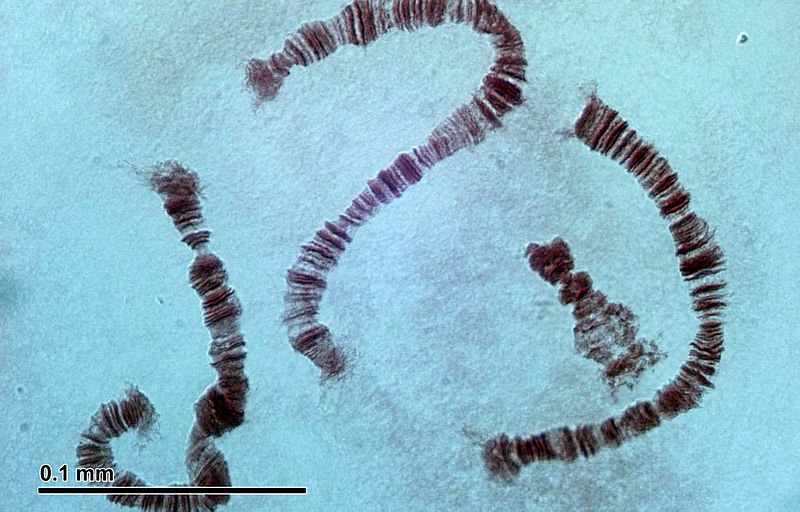
Kerala PSC HSST Botany 2012 Examination
Botany Higher Secondary School Teacher: Junior & Senior
Question Paper Code 40/2012 (Cat. NO. 449/2010)
Original question paper of Kerala PSC HSST Botany Junior / Senior (Higher Secondary School Teacher Botany), Category No. 449/2010) examination conducted by Kerala PSC (Public Service Commission) on 13/04/2002 (Q. Code 40/2012) for the appointment of HSST Botany in Government Higher Secondary Schools of Kerala under the Directorate of Higher Secondary Education, Trivandrum, Govt. of Kerala. Questions are in MCQ (Multiple Choice Questions) format.
Part – 1 (Questions 1 – 25)
(1). Key enzyme in PCR:
a. Taq polymerase
b. EcoRI
c. Restriction endonuclease
d. Ligase
Ans. (a). Taq polymerase
Taq DNA polymerase is a thermostable DNA polymerase enzyme obtained from a thermophilic bacterium Thermus aquaticus. Taq DNA polymerase is frequently used polymerase enzyme in Polymerase Chain Reaction (PCR). The optimum temperature for Taq DNA polymerase is 72oC. Taq DNA polymerase does not have the 3’ – 5’ exonuclease proof reading activity and thus the fidelity of this enzyme is relatively low. Taq DNA polymerase adds a 3’ ‘A’ (adenine) overhang at the 3’ end of PCR products. This property can be used in the ‘TA’ cloning procedure where the PCR products can be easily ligated (cloned) to a vector containing ‘T’ overhangs.
Pfu polymerase is another thermostable DNA polymerase used in PCR, isolated from the bacterium Pyrococcus furiosus. The advantage of using Pfu polymerase over Taq polymerase is that, Pfu polymerase enzyme processes the 3’ – 5’ exonuclease proof reading activity and hence this enzyme shows high fidelity.
EcoRI: restriction enzymes obtained from E. coli.
Restriction enzyme: also called as molecular scissors, are endonuclease enzymes with cut DNA on specific sites, they are important tool in genetic engineering.
Ligase: a class of enzyme which joins two molecules by the formation of new covalent bonds between the two molecules with energy obtained from ATP cleavage. DNA ligase is a type of ligase which catalyzes the formation of phosphodiester bond between two nucleotides.
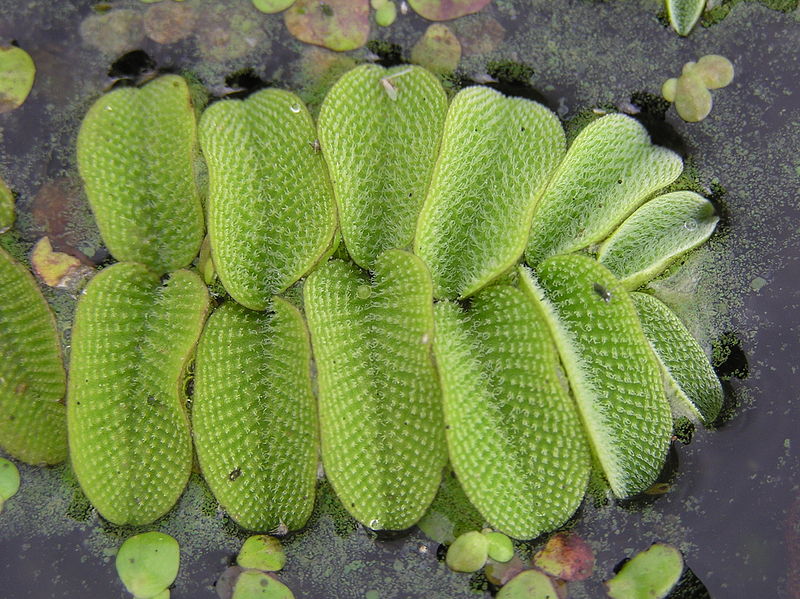
Salvinia (source wikipedia)
(2). Rootless plant:
a. Rhizophora
b. Azolla
c. Salvinia
d. Grass
Ans. (c). Salvinia
Salvinia is a rootless Pteridophyte. In Salvinia, leaves are in trimerous whorls. Among the three leaves in one whorl, two are green and photosynthetic. The third leaf, which is positioned at the lower side is highly dissected, pendulous and root like. Submerged leaves bear the sori.
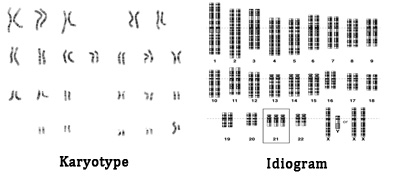
Human Karyotype & Idiogram (source Wikipedia)
(3). Diagrammatic representation of chromosome of an organism arranged according to their size is called:
a. Genotype
b. Genome
c. Idiogram
d. Phenotype
Ans. (c). Idiogram
Karyotype: a set of features that describe the chromosome constitution of an organism. Karyotype is prepared by taking the photographs of metaphase chromosome and arranging individual chromosomes in the order or their decreasing size.
Idiogram: diagrammatic representation of karyotype
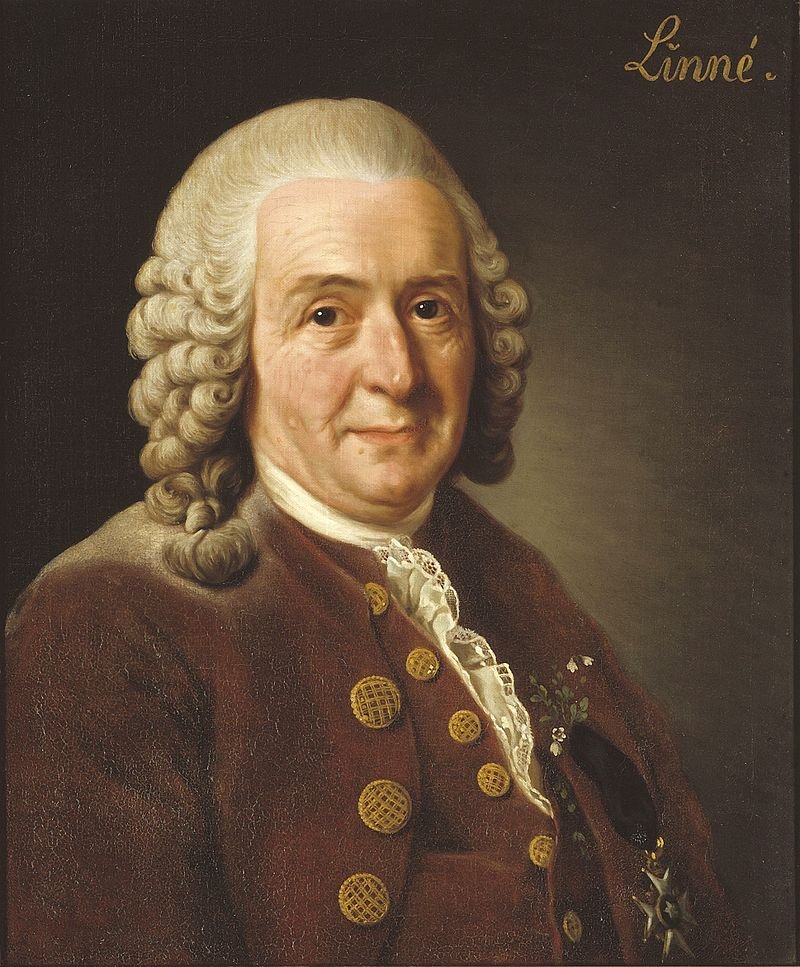
Linnaeus: Father of Taxonomy (source Wikipedia)
(4). Father of green revolution in India:
a. Linnaeus
b. Haberlandt
c. K. Ramaih
d. M.S. Swaminathan
Ans. (d). M.S. Swaminathan
Carl Linnaeus: father of taxonomy, he introduced binomial nomenclatural system, his important publication is Species plantarum (1753)
Gottlieb Haberlandt: father of plant tissue culture
M.S. Swaminathan: father of green revolution in India
Norman Ernest Borlaug: father of green revolution, developed semi-dwarf high yielding wheat varieties.
Source of dwarf gene for wheat: Norin 10, a Japanese dwarf variety of wheat.
Source of dwarf gene for rice: sd1 from DGWG (Dee-Gee-Woo-Gen)
(5). Which of the following is a petrocrop?
a. Jatropha
b. Fossil
c. Limestone
d. Crotalaria
Ans. (a). Jatrapha
Petrocrop: plants which has potential use as biofuels
(6). Verticillaster inflorescence is found in:
a. Apiaceae
b. Lamiaceae
c. Rutaceae
d. Apocynaceae
Ans. (b). Lamiaceae
(7). Botanical database of plant specimens
a. BLAST
b. Plant
c. Tropicos
d. Linux
Ans. (c). Tropicos
Tropicos is an online botanical database maintained by Missouri Botanical Garden, United States. It contains the taxonomic information of plants mainly from the regions of central and South America.
Website url: http://www.tropicos.org/
BLAST (Basic Local Alignment Search Tool) is an algorithm for comparing biological sequence information, such as nucleotide sequence of DNA or amino acid sequence of proteins.
Linux: a computer operating system coming under ‘free and open-source software’
(8). The giant nature of salivary gland chromosome is due to:
a. Endomitosis
b. Mitosis
c. Amitosis
d. Meiosis
Ans. (a). Endomitosis
Endomitosis: the process karyokinesis (nuclear division) without cytokinesis (division of cytoplasm). Daughter chromatids are not separated and they stay together. This will increase the ploidy level in the cells exponentially in each cell division.
Amitosis: a type of cell division in some eukaryotes in which all the usual events of mitosis such as nuclear membrane disorganization, formation of mitotic spindle, condensation of chromatins and formation of chromosomes NOT occurs.
(9). Palm oil obtained from:
a. Borassus flabellifer
b. Linum usitatissimum
c. Ricinus communis
d. Elaeis guinensis
Ans. (d). Elaeis guinensis
Borassus flabellifer is Asian palmyra palm, toddy palm, or sugar palm
Linum usitatissimum: commonly called as Flax or linseed and it is the source of textile fibre linen
Ricinus communis: castor, the source of castor oil and Ricin. Ricin is a toxin and chemically it is a Lectin (lectins are proteins which specifically binds to proteins)
(10). Biological plastic:
a. Cellulose, hemicellulose, agarose
b. Cellulose, amylase, glactose
c. Cutin, lignin, suberin
d. Pectin, cutin, gelatin
Ans. (c). Cutin, Lignin, Suberin
(11). Osmotic balancer in protoplast isolation:
a. Mannitol
b. Agar agar
c. Sodium alginate
d. None of the above
Ans. (a). Mannitol
Mannitol is a sugar alcohol which alleviates or reduces osmotic stress in plants. It is produced from the sugar mannose by reduction.
Protoplast fusion or somatic fusion is a type of hybridization method where two protoplasts (plant cell without cell wall) of different genetic makeup are fused to produce a hybrid called somatic hybrid or cybrid by a process called somatic hybridixation or cybridization.
Agar-agar: a natural polysaccharide gelling agent obtained from red algae (Gelidium and Gracilaria). It contains two parts, linear polysaccharide chain of agarose and small mixtures of agaropectin. Agar-agar is extensively used as solidifying agents in tissue culture media. The purified agarose obtained from agar-agar is used as the matrix in agarose gel electrophoresis for the separation of DNA and RNA.
Sodium alginate: used for preparing the seed coat of synthetic seeds.
(12). The induction of flowering by low temperature treatment is called:
a. Cryobiology
b. Photoperiodism
c. Vernalization
d. Silviculture
Ans. (c). Vernalization
Cryobiology: branch of biology which study the effect of temperature on cells
Photoperiodism: physiological response of plants and animals to day and night duration
Silviculture: cultivation of forest trees
(13). Ruminate endosperm is seen in the family:
a. Asclepiadaceae
b. Annonaceae
c. Acanthaceae
d. Alismataceae
Ans. (b). Annonaceae
Ruminate endosperm: endosperm (nutritive tissue of seed) with any type of unevenness or irregularity. Rumination of endosperm is usually caused by the inward growth of seed coat.
(14). Electrophoretic separation is based on:
a. Atomic weight
b. Charge
c. Polarity
d. Charge and polarity
Question removed before the publication of final rank-list due to the confusion in the options provided, all options are partially correct
(15). The largest herbarium in the world is located at:
a. Geneva
b. New York
c. Kew
d. Paris
Ans. (d). Paris herbarium
Muséum National d’Histoire Naturelle, Paris, France is the largest herbarium in the world with about 9,500,000 specimens.
Herbarium of New York Botanical Garden, New York, USA is the second largest herbarium which contains 7,200,000 specimens
Royal Botanical Garden, Kew, England is the largest botanical garden; it is NOT the largest herbarium. The herbarium of Key botanical garden is ranking fourth position with 7,000,000 specimens.
Central National Herbarium, Kolkata is the largest herbarium in India with 2,000,000 specimens
(16). Greenhouse effect is caused by:
a. CO2
b. SO2
c. NO2
d. CO
Ans. (a). CO2

Catharanthus roseus (source wikipedia)
(17). Vincristin is extracted from
a. Catharanthus roseus
b. Ixora coccenia
c. Datura stramonium
d. Adathoda vasica
Ans. (a). Catharanthus roseus
Vincristine and Vinblastine are the two alkaloids extracted from Catharanthus roseus (Vinca rosea). They are effective anti-cancer drugs. They inhibit the cell division by inhibiting the mitotic spindle fibre formation by interfering with the tubulin proteins.
Datura stramonium is toxic due to the presence of tropane alkaloids atropine.
Vasicine: alkaloid obtained from Adathoda vasica (Justicia adathoda)
(18). DNA fingerprinting involves:
a. RIA
b. VNTR
c. ELISA
d. RFLP
Question removed before the publication of final rank-list due to the confusion in the options provided, both VNTR and RFLP are used in DNA fingerprinting
DNA Fingerprinting: A molecular technique where the identity of an individual is confined by the characteristics of its DNA. DNA Fingerprinting is extensively used in forensic sciences for solving parental disputes criminal investigations.
VNTR (Variable Number Tandem Repeats): they are regions of some genes where specific nucleotide sequences occur as tandem repeats. They are extensively used in DNA finger printing and forensic sciences.
RIA (Radio Immuno Assay): An in vitro assay method for quantifying antigen by specific radio-labelled antibodies.
ELISA (Enzyme Linked Immuno-Sorbent Assay): A qualitative as well as quantitative assay method to detect the level of antigens (usually proteins) by using specific antibodies which are tagged by colour producing reaction catalyzing enzymes.
RFLP (Restriction Fragment Length Polymorphism): a molecular tools to establish genetic relationships between organisms by comparing the polymorphism of fragments generated when the genomic DNA are treated with restriction enzymes.
(19). In allopatric speciation, the initial barriers for gene flow is:
a. Behavioral
b. Post zygotic
c. Geographic
d. Ecological
Ans. (c). Geographic
Allopatric speciation (reproductive isolation due to geographical barriers): a type of speciation in which the biological population is isolated due to large geographic barriers which prevent the inbreeding between these populations
Sympatric speciation (= reproductive isolation due to genetic barriers): types of speciation in a population living together in an area but some individuals are reproductively isolated from the rest of the individuals. This reproductively isolated fragment of population may evolve into new species.
(20). An example to Transgenic plant:
a. BT cotton
b. Flavr Savr Tomato
c. Golden rice
d. All of these
Ans. (d). All of these
Bt Cotton: A genetically modified cotton variety which is resistant against bollworm insect. Gene transferred Cry protein, source of gene Bacillus thuringiensis
Flavr Savr Tomato: first commercially grown genetically modified food crop, produced by the company Calgene. Tomato was made to more resistant against rotting by an antisense gene against the enzyme polygalacturonase which degrades pectin in the cell wall.
Golden rice: a genetically modified rice variety to produce more beta carotene. Beta carotene is the precursor of vitamin A.
(21). An ocean oil spillage has been cleaned used bacteria. The process is:
a. Biocatalysis
b. Bioremediation
c. Southern blotting
d. Polymerization
Ans. (b). Bioremediation
Bioremediation: a pollution or waste management method by employing living organism to remove or neutralize the pollutant.
Biocatalysis: catalysis in living cells, done by specialized proteins called enzymes
Southern blotting: A method is molecular biology in which the electrophoresis-separated DNA fragments were transferred to a nitrocellulose membrane and detected specific DNA sequence from the membrane by using radio-labeled probes.
(22). Natural rubber is a:
a. Monoterpene
b. Diterpene
c. Polyglyceride
d. Polyterpene
Ans. (d). Polyterpene
(23). A live viral vaccine
a. Pertussis
b. Typhoid
c. Poliomyelitis
d. Tetanus
Ans. (c). Poliomyelitis
Injected polio vaccine uses inactivated polio viruses
Oral polio vaccine uses wakened poliovirus
(24). In India for the first time the transgenic plants were introduced by the US company:
a. Celera genomics
b. Calgene
c. Indo American Hybrid Seeds
d. Monsanto
Ans. (d). Monsanto
Celera genomics: founded by Craig Venter, focusing of genome sequencing. Genomes sequenced by Celera genomics: Drosophila melanogaster, Human, Anopheles gambiae, Mouse and Haemophilus influenza
Calgene: Company which produced the Flavr Savr tomato, in 1996, Monsanto acquired the shares of Calgene.
Monsanto: a US based biotechnology company, they are the leading produces of genetically modified food crops and Roundup (a glyphosate) based herbicide.
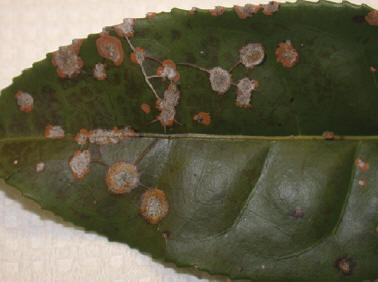
Blister Blight of Tea
(25). Blister blight of tea is caused by:
a. Aternaria solanii
b. Puccinia graminis
c. Exobasidium vexans
d. Mycoplasma
Ans. (c). Exobasidium vexans
Alternari solanii causes ‘Target Board’ syndrome in cultivated crops
Puccinia graminis causes red rust of wheat
You may also like..
@. PSC HSST 2012 Botany Part II
@. PSC HSST 2012 Botany Part III
@. PSC HSST 2012 Botany Part IV
@. Kerala-PSC HSST Botany 2006 Question Paper (PDF)
@. PSC Botany Lecturer Question paper: Set 1, Set 2, Set 3, Set 4
@. CSIR Life Sciences Previous Year Question Papers
@. Biology MCQ
Please Share for your Students, Colleagues, Friends and Relatives…
